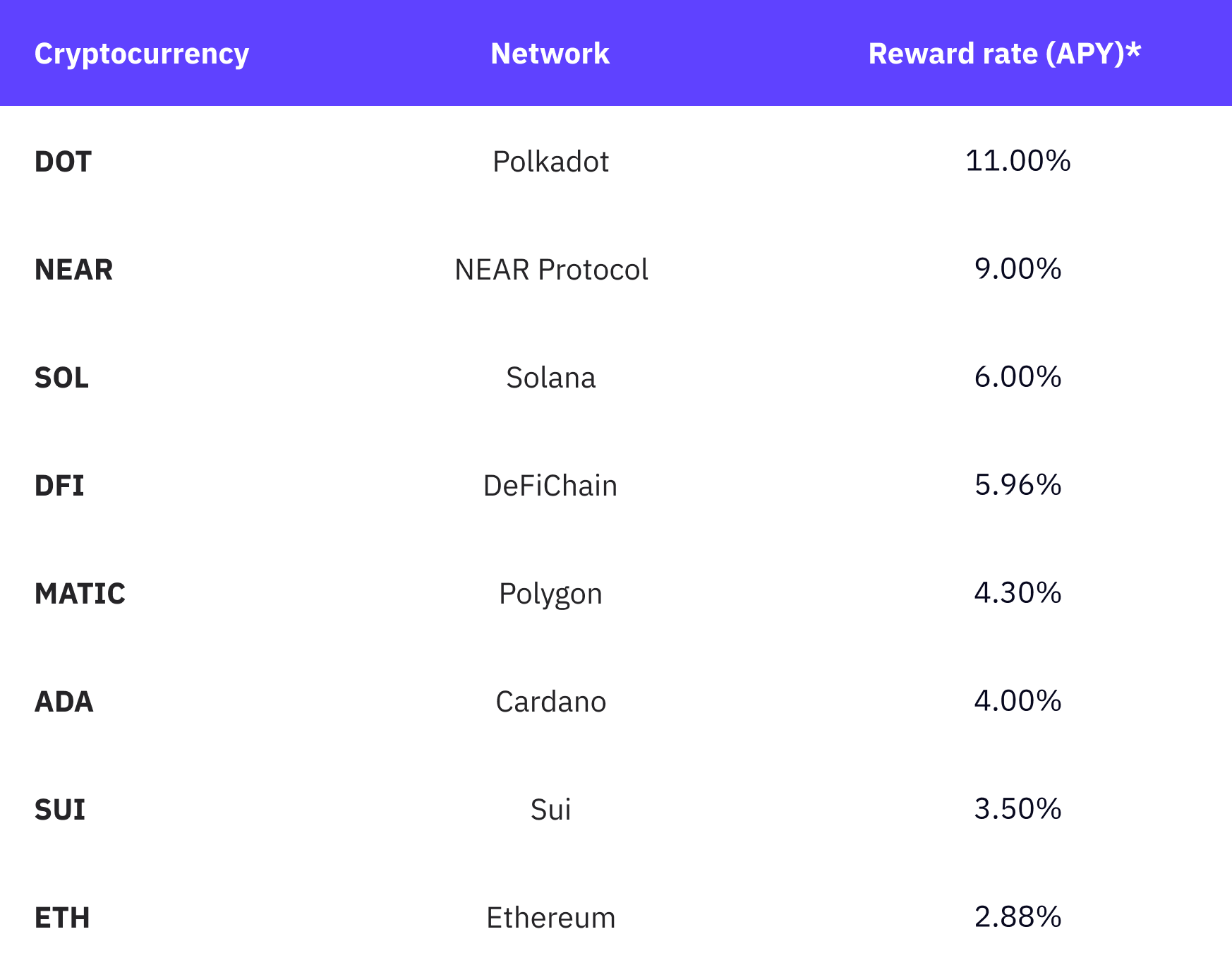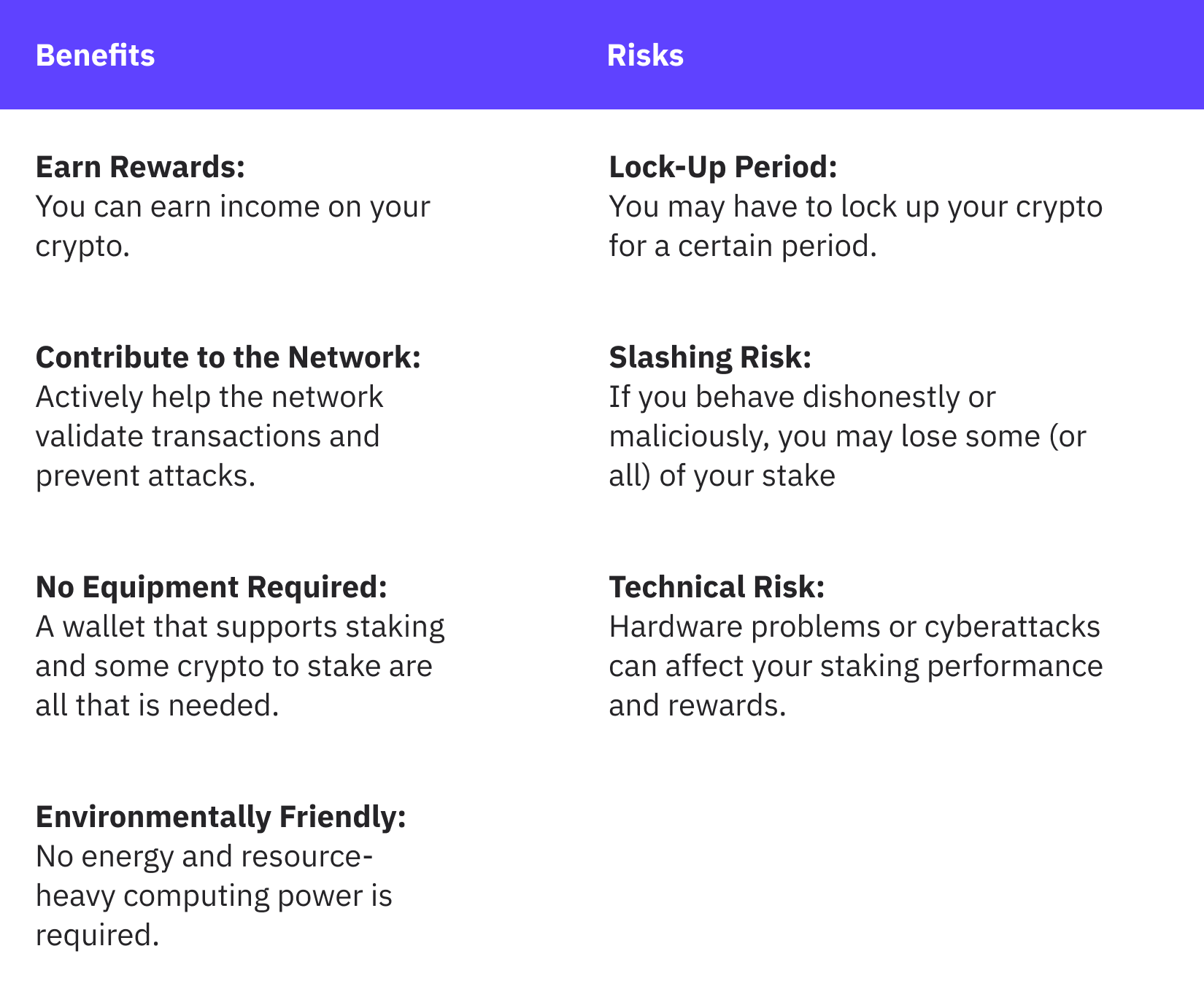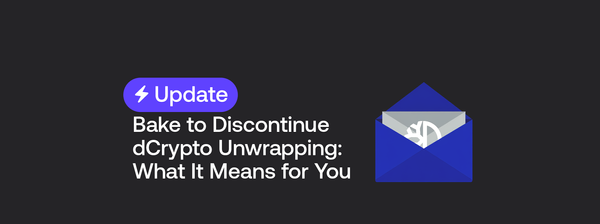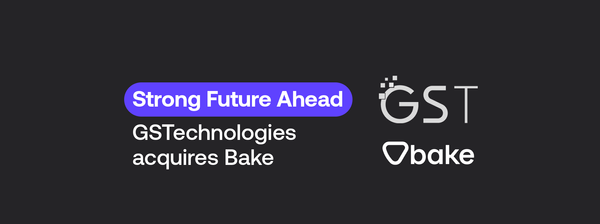What Is Staking? The Ultimate Guide
Staking is a form of “actively holding” your cryptocurrency in order to receive rewards. It works in a similar way to a fixed-term deposit in a bank account. You keep your funds in an allocated account for a specific period, and in return, you earn some money.
However, unlike a bank, your money is not lent out to other customers or placed in risky investments. When you stake crypto, your assets are used to maintain the integrity and security of a blockchain network — which rewards you directly for doing so.
In this guide, we’ll explore in detail what crypto staking is, discover exactly how it works, and explain how you can start staking your crypto using Bake.
How Does Staking Crypto Work?
To understand how staking can be integral to a blockchain network, we first need to look at the underlying mechanics.
Proof-of-Stake (PoS)
Staking is the lifeblood of networks using a Proof-of-Stake (PoS) consensus mechanism.
What’s a consensus mechanism?
It is how a blockchain reaches an agreement on whether the transactions happening on the network are valid or not. It is what ensures that everyone has the same version of the truth, and no one can cheat or manipulate the system.
The Proof-of-Stake consensus mechanism achieves this by requiring users to stake their crypto to participate in the network. Users that do so are known as “validators.”
Role of Validators
To become a validator, you must stake a certain amount of cryptocurrency on the network for a specified period of time. The amount and time period are different for each blockchain.
By becoming a validator, you are literally putting your money where your mouth is. You show your commitment to the network by putting your own crypto at ‘stake’ if you were to ever act maliciously.
Creating and Validating New Blocks
Once you become a validator, you can start creating and validating new blocks of transactions. Depending on the network, this can be done in different ways:
- Random selection: validators are chosen at random to propose new blocks.
- Voting system: validators vote on which block to add.
- Combination of both: elements of both random selection and a voting system are used.
In any case, validators need to follow the rules and protocols of the network. They need to ensure that the transactions in each block are valid and do not conflict with each other or with previous blocks. They also need to check that each block has the correct cryptographic signature (a digital proof that verifies its authenticity).
If a validator approves an invalid or fraudulent block, they run the risk of losing their stake.
Earning Rewards
For their service to the network, validators earn rewards. These rewards come in two forms: block rewards and transaction fees.
Block rewards are new coins that are created and distributed to validators as an incentive to maintain the network.
Transaction fees are small amounts that users pay to send transactions on the network.
The amount and frequency of the rewards depend on which network you are staking on.
Staking Pools
Being a validator comes with three major requirements:
1. You need to have enough coins to stake on the network.
2. You must have a reliable and secure computer connected to the internet.
3. You must have the technical knowledge to set up and run your own node.
This can make staking inaccessible for some users — especially those with limited resources.
That’s where staking pools come in.
Staking pools are groups of users who pool their coins and resources together to stake on the network. They share the costs and responsibilities of being a validator, as well as the rewards and risks of staking.
Staking pools are usually managed by a pool operator, who takes care of the technical aspects and charges a fee for their service. You can enjoy the benefits of staking without having to deal with the pain points.
You can find staking pools on various platforms and websites that offer staking services. However, not all of them are trustworthy. Make sure to do your research before entrusting your crypto to anyone.
How Do I Start Staking Crypto?
Select the Right Crypto
The first step to begin staking is to choose which cryptocurrency you want to stake. Not all cryptocurrencies support staking. You need to find ones that use PoS or a variant of it.
Some of the most popular cryptocurrencies that support staking include:

*rewards rates can fluctuate depending on the network conditions and the number of validators
Choose the Right Wallet
The next step is to choose the right crypto wallet to stake through.
There are different types of crypto wallets, such as web wallets, mobile wallets, desktop wallets, hardware wallets, etc. Each type has its own advantages and disadvantages regarding security, convenience, and functionality.
Some wallets are dedicated to specific cryptocurrencies, while others support multiple.
Some wallets are officially endorsed by the developers of the cryptocurrency, while others are third-party and independent.
For staking purposes, you need a wallet that supports the staking features and functions of your chosen cryptocurrency. If the wallet provider is reputable, you will be able to find this out directly from them. Otherwise, it is best to seek help directly from the official support channels of the cryptocurrency you wish to stake.
Start Staking
The final step is to actually stake your crypto. You can do this directly through your chosen wallet’s interface.
Certain cryptocurrencies have a fixed or minimum amount you must stake, while others are more flexible. Others require you to ‘lock’ your crypto on the network, where you will not be able to withdraw or spend your crypto until the lock-up period is over.
If you use Bake’s staking service, the process is streamlined for ease and efficiency. You can start staking any amount on Bake within just a few clicks and track your rewards in real time within the app.
What Are the Benefits of Staking Crypto?
Earn Rewards
The most obvious benefit of staking is the rewards. Staking allows you an easy and secure way to generate income from your crypto.
Contribute to the Network
Staking helps validate transactions and prevent attacks on the network. By staking, you become part of the network, helping it to run smoothly and efficiently. You are actively contributing to the continued success of your preferred cryptocurrency.
No Equipment Required
Staking does not need any specialized equipment or resources to run. All you need is a wallet that supports staking and some crypto. This makes staking more accessible and convenient for anyone who wants to participate.
Environmentally Friendly
Staking is environmentally friendly and sustainable. It relies on the stake of the validators rather than their computing power. Making it a much greener way to support a blockchain network compared to alternative methods.

What Are the Risks of Staking Crypto?
Lock-Up Period
When staking on some networks or specific wallets, you may be required to “lock-up“ your crypto for a certain amount of time. This means you cannot access your staked assets until the end of the “lock-up’ period.
Slashing Risk
You are exposed to losing your stake (or a portion of it) if you act dishonestly or maliciously on the network. This is known as “Slashing” and can result in losing your crypto, reputational damage, and reduced rewards.
Technical Risk
Staking requires you to maintain your own hardware (when not using a staking pool/service). This can leave you prone to bugs, hardware failures, network disruptions, or cyberattacks, which can affect your staking performance and rewards.
Get Started with Crypto Staking on Bake
Bake’s Staking service takes care of everything for you. There is no need to worry about setting up hardware or downloading different wallets.
Simply download the Bake Mobile app, register (and verify) an account, and you can start staking in just a few clicks.
Ethereum (ETH), Polkadot (DOT), DeFiChain (DFI), Solana (SOL), Polygon (MATIC), Cardano (ADA), NEAR Protocol (NEAR), and Sui (SUI) are all available to stake on Bake.
There are no lock-in periods for any of Bake’s staking services. You can stake and unstake* your crypto whenever you please without any fees or penalties.
Find out more about Bake staking and other Bake services.
*NEAR and DOT currently require an unstaking period of 3 days and 5 days, respectively.

DISCLAIMER: Please note that the information on this blog and in any articles posted on this blog is for general information only and should not be relied upon as financial advice. Cake Pte. Ltd., Bake, UAB, and its affiliates (the “Cake Group”) are not licensed financial advisers. You may wish to approach your own independent financial advisor before making any decision to buy, sell or hold any product and/or digital assets mentioned in this blog.
Any views, opinions, references, assertions of fact and/or other statements are not necessarily the views held by the Cake Group. The Cake Group disclaims any liability whatsoever that may arise out of or in connection with such statements. Always do your own research before investing in any financial assets and consult a qualified financial advisor if necessary.




